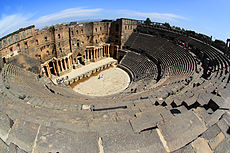Bosra
Bosra
بصرى | |
|---|---|
| Country | |
| Governorate | Daraa Governorate |
| District | Daraa District |
| Area code | 15 |
| UNESCO World Heritage Site | |
|---|---|
 | |
| Criteria | Cultural: i, iii, iv |
| Reference | 22 |
| Inscription | 1980 (4th Session) |
Bosra (Template:Lang-ar Buṣrā), also known as Bostra, Busrana, Bozrah, Bozra, Busra Eski Şam, Busra ash-Sham, and Nova Trajana Bostra, is an ancient city administratively belonging to the Daraa Governorate in southern Syria. It is a major archaeological site and has been declared a UNESCO World Heritage Site.
History
The settlement was first mentioned in the documents of Tutmose III and Akhenaton (14th century BC). Bosra was the first Nabatean city in the 2nd century BC. The Nabatean Kingdom was conquered by Cornelius Palma, a general of Trajan, in 106.

Under the Roman Empire, Bosra was renamed Nova Trajana Bostra, and was the residence of the legio III Cyrenaica and capital of the Roman province Arabia Petraea. The city flourished and became a major metropolis at the juncture of several trade routes, including the Roman road to the Red Sea. The two Councils of Arabia were held at Bostra in 246 and 247 AD. The city was conquered by the Sassanid Persians in the early 7th century, and, after a short Byzantine reconquest, was finally captured by the forces of the Rashidun Caliphate under Khalid ibn Walid in the Battle of Bosra (634). Thereafter it was an Islamic possession.
Bosra played an important part in the early life of the Prophet of Islam, Mohammed as described in the entry for the Christian Monk, Bahira. Bahira was witnessing to Muhammad in the prophethood.
Today, Bosra is a major archaeological site, containing ruins from Roman, Byzantine, and Muslim times, its main feature being the well preserved Roman theatre. Every year there is a national music festival hosted in the main theater.
Main sights
Of the city which once counted 80,000 inhabitants, there remains today only a village settled among the ruins. The second century Roman theater, constructed probably under Trajan, is the only monument of this type with its upper gallery in the form of a covered portico which has been integrally preserved. It was fortified between 481 and 1231 AD.
Further, Nabatean and Roman monuments, Christian churches, mosques and Madrasahs are present within the half ruined enceinte of the city. The structure of this monument a central plan with eastern apses flanked by 2 sacristies exerted a decisive influence on the evolution of Christian architectural forms, and, to a certain extent, on Islamic style as well. Al-Omari Mosque of Bosra is one of the oldest surviving mosques in Islamic history.[1]
Close by are the Kharaba Bridge and the Gemarrin Bridge, both Roman bridges.


Notable people from Bosra
- Titus of Bostra, fl. 4th century, Christian theologian
- Saint Antipater of Bostra, fl. 5th century, Christian bishop
- Bahira, ca. 600 AD, Assyrian monk
- Ibn Kathir (1301–1373), Islamic scholar
- Modar AlMekdad Aluminum Science expert.
References
- ^ Al-Omari Mosque Archnet Digital Library.
External links
- Catholic Encyclopedia on Bosra
- Official website of Bosra city
- Bosra World Heritage site in panographies - 360 degree interactive imaging
- Extensive photo site about Bosra
- Photo Gallery of Bosra
32°31′N 36°29′E / 32.517°N 36.483°E
